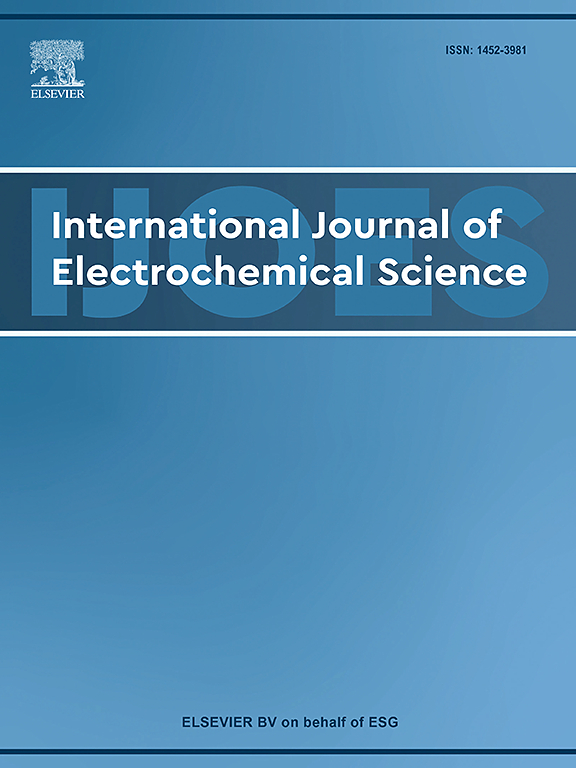高性能二氧化碳电还原单原子催化剂的最新进展:合成策略和电化学前沿
IF 2.4
4区 化学
Q4 ELECTROCHEMISTRY
International Journal of Electrochemical Science
Pub Date : 2025-07-23
DOI:10.1016/j.ijoes.2025.101131
引用次数: 0
摘要
电化学二氧化碳还原反应(CO2RR)是减少温室气体排放,同时从可再生碳源生产增值化学品和燃料的基础技术。该技术的发展取决于高活性、选择性和稳定性的电催化剂的设计。单原子催化剂(SACs)以原子分散的金属中心固定在支撑材料上为特征,已经成为催化科学的前沿,为CO2RR提供了前所未有的机会。通过最大限度地提高原子利用效率和提供独特的、可调的协调环境,SACs弥合了均相和多相催化之间的差距,实现了高性能和基本机制的理解。本文综述了CO2RR的SACs领域的最新突破,并对其进行了全面和批判性的分析。我们首先深入研究先进的合成策略,包括湿化学方法、高温热解和原子层沉积,重点是控制孤立原子位点形成和稳定的原理。随后,我们调查了电化学前沿,系统地评估了最先进的sac在选择性生产一氧化碳(CO),甲酸(HCOOH)和多碳(C2 +)化合物等关键产品方面的性能。本综述的中心主题是结构-性能关系的阐明,其中我们将催化剂的原子和电子结构的合成控制与其产生的电化学行为联系起来,强调了从operando光谱技术和密度泛函理论(DFT)计算的强大组合中获得的见解。最后,我们解决了目前阻碍sac实际应用的主要挑战-特别是工业相关设备中的稳定性,可扩展性和性能问题-并为未来的研究方向提供了前瞻性的视角,准备克服这些障碍,包括多原子活性位点的设计和人工智能在催化剂发现中的集成。本文章由计算机程序翻译,如有差异,请以英文原文为准。
Recent advances in single-atom catalysts for high-performance carbon dioxide electroreduction: Synthetic strategies and electrochemical frontiers
The electrochemical carbon dioxide reduction reaction (CO2RR) represents a cornerstone technology for mitigating greenhouse gas emissions while simultaneously producing value-added chemicals and fuels from a renewable carbon source. The development of this technology hinges on the design of highly active, selective, and stable electrocatalysts. Single-atom catalysts (SACs), which feature atomically dispersed metal centers anchored on a support material, have emerged as a frontier in catalysis science, offering unprecedented opportunities for CO2RR. By maximizing atom-utilization efficiency and providing a unique, tunable coordination environment, SACs bridge the gap between homogeneous and heterogeneous catalysis, enabling both high performance and fundamental mechanistic understanding. This review provides a comprehensive and critical analysis of recent breakthroughs in the field of SACs for CO2RR. We first delve into advanced synthetic strategies, including wet-chemistry methods, high-temperature pyrolysis, and atomic layer deposition, with a focus on the principles governing the formation and stabilization of isolated atomic sites. Subsequently, we survey the electrochemical frontiers, systematically evaluating the performance of state-of-the-art SACs for the selective production of key products such as carbon monoxide (CO), formate (HCOOH), and multicarbon (C2 +) compounds. A central theme of this review is the elucidation of structure-performance relationships, where we connect synthetic control over the catalyst's atomic and electronic structure with its resulting electrochemical behavior, highlighting insights gained from a powerful combination of operando spectroscopic techniques and density functional theory (DFT) calculations. Finally, we address the overarching challenges that currently impede the practical application of SACs—notably issues of stability, scalability, and performance in industrial-relevant devices—and offer a forward-looking perspective on the future research directions poised to overcome these hurdles, including the design of multi-atom active sites and the integration of artificial intelligence in catalyst discovery.
求助全文
通过发布文献求助,成功后即可免费获取论文全文。
去求助
来源期刊
CiteScore
3.00
自引率
20.00%
发文量
714
审稿时长
2.6 months
期刊介绍:
International Journal of Electrochemical Science is a peer-reviewed, open access journal that publishes original research articles, short communications as well as review articles in all areas of electrochemistry: Scope - Theoretical and Computational Electrochemistry - Processes on Electrodes - Electroanalytical Chemistry and Sensor Science - Corrosion - Electrochemical Energy Conversion and Storage - Electrochemical Engineering - Coatings - Electrochemical Synthesis - Bioelectrochemistry - Molecular Electrochemistry

 求助内容:
求助内容: 应助结果提醒方式:
应助结果提醒方式:


